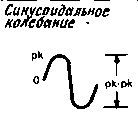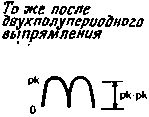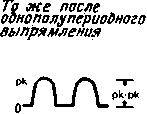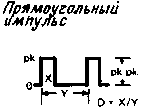Table of conversion factors for various AC waveforms. Encyclopedia of radio electronics and electrical engineering

Encyclopedia of radio electronics and electrical engineering / Amateur radio calculations
 Comments on the article
Comments on the article
By using the conversion factor table below, you can expand the capabilities of any available AC voltmeter. This table makes it very easy to measure any parameter of a range of AC signals using any AC voltmeter.
Most AC voltmeters are designed to accurately measure a single signal parameter, such as peak-to-peak, peak-to-peak, RMS, or average. Such a limitation can cause certain inconveniences in cases where there is no appropriate instrument for measuring the required signal parameter or when measuring non-sinusoidal signals.
At the same time, using this table of conversion factors, almost any AC voltmeter can be used to accurately measure the peak-to-peak, peak-to-peak, RMS, and average value of a range of pulsed, sine, and triangular waveforms.
The conversion factors given in the table for instruments that measure the average value, but are calibrated in rms values, will probably be most useful, since in this case confusion and errors are most often observed when measuring non-sinusoidal signals.
The table is used as follows: the conversion factor for the type of voltmeter used and the signal value to be measured are found, and then the voltmeter reading is simply multiplied by this factor.
Suppose you want to determine the RMS value of a sawtooth signal, and you have an AC voltmeter that responds to the average value and is calibrated so that its reading is equal to the RMS value of a sinusoidal signal. It follows from the table that in this case the conversion factor will be equal to 1,038. The instrument reading must therefore be multiplied by this number.
To measure rectangular pulses with a duty cycle other than 50%, first find their actual duty cycle D and then change the voltmeter reading as shown in the table. The conversion factors given for white (Gaussian) noise are approximate values.
The accuracy of determining some of the conversion factors given in the table depends on how accurately the measured signals coincide in their form with the ideal ones. Distortion in the mains supply and imperfection of rectifiers can introduce significant errors in the measurement results of the rectified sinusoidal voltage. In addition, simple peak detectors (rectifiers) with capacitors in series will produce large errors when used to measure unbalanced waveforms such as rectified sine or symmetrical square wave and pulsed waveforms.
Voltmeter graduation
| Waveform |
full swing |
True amplitude |
Measures amplitude, graduated in eff. significant. for sinusoidal signal |
Eff. meaning |
Measures among the value, graduated in eff. significant. for sinusoidal signal |
True mean |
 |
pk-pk
0 pk
eff.
avg. |
1.000
0.500
0.353
0.318 |
2.000
1.000
0.707
0.637 |
2.828
1.414
1.000
0.900 |
2.828
1.414
1.000
0.900 |
2.828
1.414
1.000
0.900 |
3.140
1.570
1.111
1.000 |
 |
pk-pk
0 pk
eff.
avg. |
1.000
1.000
0.707
0.637 |
1.000
1.000
0.707
0.637 |
1.414
1.414
1.000
0.900 |
1.414
1.414
1.000
0.900 |
1.414
1.414
1 000
0.900 |
1.570
1.570
1.111
1.000 |
 |
pk-pk
0 pk
eff.
avg. |
1.000
1.000
0.500
0.318 |
1.000
1.000
0.500
0.318 |
1.414
1.414
0.707
0.450 |
2.000
2.000
1.000
0.637 |
2.828
2.828
1.414
0.900 |
3.140
3.140
1.570
1.000 |
 |
pk-pk
0 pk
eff.
avg. |
1.000
0.500
0.500
0.500 |
2.000
1.000
1.000
1.000 |
2.828
1.414
1.414
1.414 |
2.000
1.000
1.000
1.000 |
1.800
0.900
0.900
1.900 |
2.000
1.000
1.000
1.000 |
 |
pk-pk
0 pk
eff.
avg. |
1.000
1.000
0.707
0.500 |
1.000
1.000
0.707
0.500 |
1.414
1.414
1.000
0.707 |
1.414
1.414
1.000
0.707 |
1.800
1.800
1.272
0.900 |
2.000
2.000
1.414
1.000 |
 |
pk-pk
0 pk
eff.
avg. |
1.000
1.000
D1/2
D |
1.000
1.000
D1/2
D |
1.414
1.414
1.414D1/2
1.414 D |
1 / D1/2
1 / D1/2
1.000
D1/2 |
0.9 / D
0.9 / D
0.9 / D1/2
0.9D |
1 / D
1 / D
1 / D1/2
1.000 |
 |
pk-pk
0 pk
eff.
avg. |
1.000
0.500
0.289
0.250 |
2.000
1.000
0.577
0.500 |
2.828
1.414
0.816
0.707 |
3.464
1.732
1.000
0.867 |
3.600
1.800
1.038
0.900 |
4.000
2.000
1.153
1.000 |
 |
pk-pk
0 pk
eff.
avg. |
See notes
see notes
See notes
see notes |
-
-
1.000
0.798 |
-
-
1.127
0.900 |
-
-
1.253
1.000 |
1. Apparent total noise swing (width of the screen area occupied by the waveform image) ~ 6 eff. values (with 99,5% probability of an instantaneous burst of noise exceeding this level)
2. Tangentially measured total noise amplitude ~ 2 eff. values
3. Apparent total noise amplitude ~ 3 tangentially measured noise amplitudes:
Table (graphical representation)
Author: M. J. Salvati; Publication: N. Bolshakov, rf.atnn.ru
 See other articles Section Amateur radio calculations.
See other articles Section Amateur radio calculations.
 Read and write useful comments on this article.
Read and write useful comments on this article.
<< Back
 Latest news of science and technology, new electronics:
Latest news of science and technology, new electronics:
Air trap for insects
01.05.2024
Agriculture is one of the key sectors of the economy, and pest control is an integral part of this process. A team of scientists from the Indian Council of Agricultural Research-Central Potato Research Institute (ICAR-CPRI), Shimla, has come up with an innovative solution to this problem - a wind-powered insect air trap. This device addresses the shortcomings of traditional pest control methods by providing real-time insect population data. The trap is powered entirely by wind energy, making it an environmentally friendly solution that requires no power. Its unique design allows monitoring of both harmful and beneficial insects, providing a complete overview of the population in any agricultural area. “By assessing target pests at the right time, we can take necessary measures to control both pests and diseases,” says Kapil ... >>
The threat of space debris to the Earth's magnetic field
01.05.2024
More and more often we hear about an increase in the amount of space debris surrounding our planet. However, it is not only active satellites and spacecraft that contribute to this problem, but also debris from old missions. The growing number of satellites launched by companies like SpaceX creates not only opportunities for the development of the Internet, but also serious threats to space security. Experts are now turning their attention to the potential implications for the Earth's magnetic field. Dr. Jonathan McDowell of the Harvard-Smithsonian Center for Astrophysics emphasizes that companies are rapidly deploying satellite constellations, and the number of satellites could grow to 100 in the next decade. The rapid development of these cosmic armadas of satellites can lead to contamination of the Earth's plasma environment with dangerous debris and a threat to the stability of the magnetosphere. Metal debris from used rockets can disrupt the ionosphere and magnetosphere. Both of these systems play a key role in protecting the atmosphere and maintaining ... >>
Solidification of bulk substances
30.04.2024
There are quite a few mysteries in the world of science, and one of them is the strange behavior of bulk materials. They may behave like a solid but suddenly turn into a flowing liquid. This phenomenon has attracted the attention of many researchers, and we may finally be getting closer to solving this mystery. Imagine sand in an hourglass. It usually flows freely, but in some cases its particles begin to get stuck, turning from a liquid to a solid. This transition has important implications for many areas, from drug production to construction. Researchers from the USA have attempted to describe this phenomenon and come closer to understanding it. In the study, the scientists conducted simulations in the laboratory using data from bags of polystyrene beads. They found that the vibrations within these sets had specific frequencies, meaning that only certain types of vibrations could travel through the material. Received ... >>
 Random news from the Archive Random news from the Archive Increased sodium-ion battery capacity
11.09.2021
Scientists at Chalmers University of Technology (Sweden) have used graphene to create a new type of anode for sodium-ion batteries, making them comparable in capacity to lithium-ion batteries.
Sodium-ion batteries are not used as often in mobile devices, since traditional lithium-ion batteries offer 2 times the energy density - 285 kWh / kg.
Sodium-ion battery (Na-ion) is a type of electric battery that has almost identical energy characteristics to a lithium-ion battery, but the cost of materials used in it is much lower. The big advantage of sodium-ion batteries is that they can be safely discharged to zero, which makes them safer to transport and store.
The specialists found that with a new type of graphene electrode, a sodium-ion battery is able to demonstrate similar performance: this material is able to hold the same number of sodium ions.
Sodium-ion batteries are more stable and have a lower cost - in electric vehicles and electronics they will prove useful, while lithium-ion batteries can be dangerous when overheated.
For fast charging and high battery capacity, ions must easily enter the anode material. The sodium-ion battery cathode is made from sodium oxides, and a carbon-based material is used as the anode. It can be activated carbon, but it is expensive and it is difficult to produce such cathodes. Graphite is an inexpensive analogue, but sodium ions cannot move efficiently between graphene layers.
To overcome this problem, scientists have created a new material that consists of alternating layers of graphene and benzene. The benzene layer increases the distance between the graphene layers, allowing sodium ions to move freely. In addition, benzene can form a strong bond with sodium ions.
According to the authors of the project, the capacity of such a battery is comparable to that of a lithium-ion battery: with pure graphite, the energy density is 30 mAh / g, and with the new material it rises to more than 330 mAh / g.
|
 Other interesting news:
Other interesting news:
▪ Gut microflora affects our health and mood
▪ New series CKR relay Crydom
▪ Sound waves are the carrier of mass
▪ A simple method to obtain black silicon for solar panels
▪ Seagate BarraCuda 510 M.2 SSDs
 News feed of science and technology, new electronics
News feed of science and technology, new electronics
 Interesting materials of the Free Technical Library:
Interesting materials of the Free Technical Library:
▪ site section Voltage converters, rectifiers, inverters. Article selection
▪ article Miracle stove. Tips for the home master
▪ article What is the total mass content in the earth's crust of the rarest chemical element? Detailed answer
▪ article Screwdriver with clip. home workshop
▪ article Quad-channel home theater amplifier with LG player remote control. Encyclopedia of radio electronics and electrical engineering
▪ article On oscillations and waves. Encyclopedia of radio electronics and electrical engineering
 Leave your comment on this article:
Leave your comment on this article:
 All languages of this page
All languages of this page
Home page | Library | Articles | Website map | Site Reviews

www.diagram.com.ua
2000-2024







 Arabic
Arabic Bengali
Bengali Chinese
Chinese English
English French
French German
German Hebrew
Hebrew Hindi
Hindi Italian
Italian Japanese
Japanese Korean
Korean Malay
Malay Polish
Polish Portuguese
Portuguese Spanish
Spanish Turkish
Turkish Ukrainian
Ukrainian Vietnamese
Vietnamese








 Leave your comment on this article:
Leave your comment on this article: